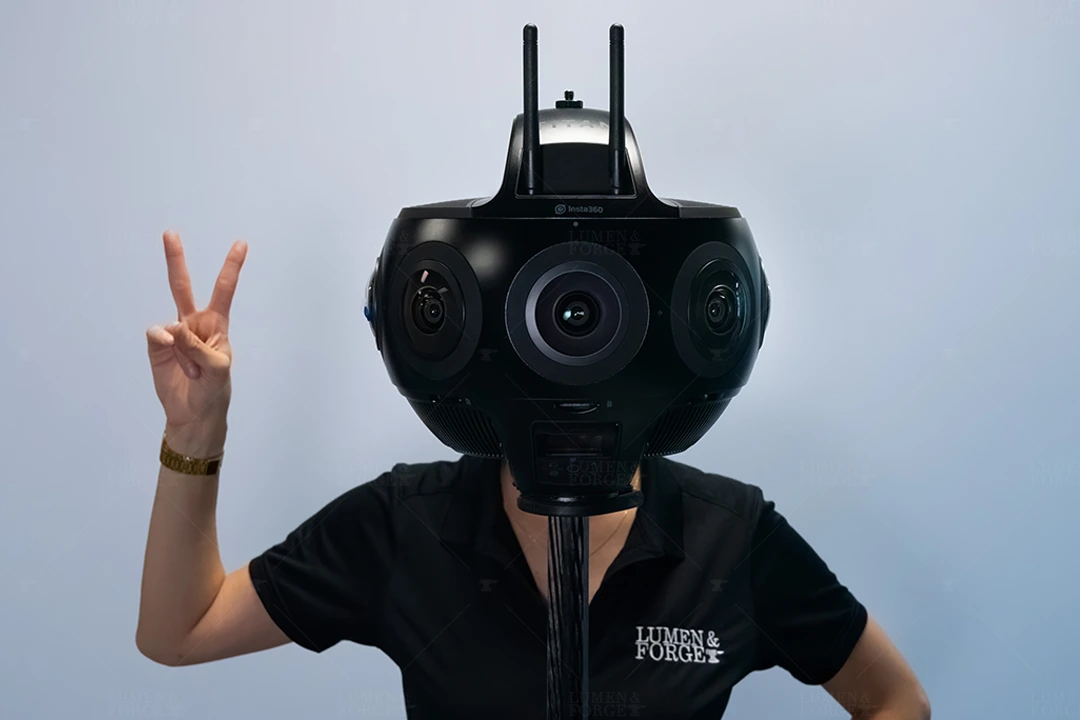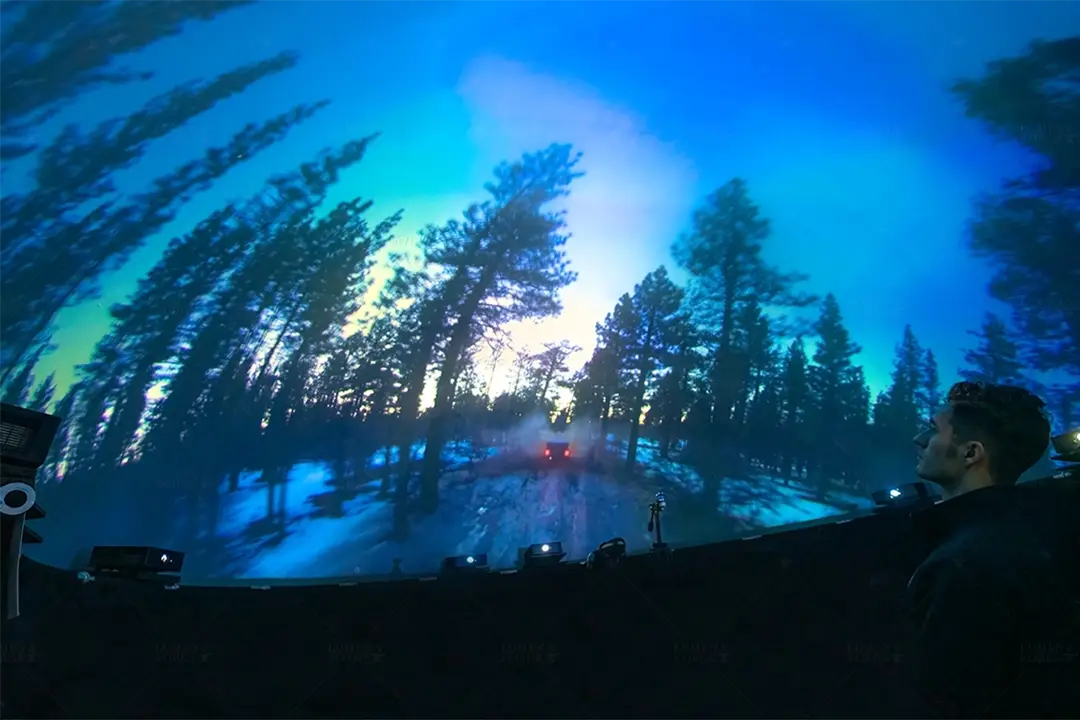360° video is only getting easier to capture as the technology continues to develop. What was once a very experimental recording method has now become so common that it’s more accessible to consumers than ever before.
But, what is 360° video, and where do you start if you want to learn how to shoot it? We’re going to go over everything the average beginner needs to know to start shooting 360° video.
What Is 360-degree Video?
Before you learn how to shoot a 360° video, it’s important first to understand how the process works. As the name suggests, 360° video refers to footage that has been recorded in a way that captures everything in every direction at the same time. This is in contrast to traditional cameras that capture a fixed, rectangular field of view.
There are two ways you can go about capturing 360° videos: using a 360° video camera or using several individual cameras in a configuration that allows them to capture multiple angles, known as a multi-camera array or multi-camera rig. As capturing 360° video using a camera array is a much more advanced topic, we’re going to focus on the simpler (and much more consumer-friendly) 360° video cameras.
To capture 360° video, 360° video cameras use multiple lenses to capture everything simultaneously. These individual videos are then stitched together using software to create a spherical view of the footage. In doing so, viewers can then interact with the video to change their point of view, giving the feeling that they’ve been placed in the scene rather than merely observing it.

The Benefits and Drawbacks of 360-degree Video
While 360° video is a unique and interesting way to capture footage, it’s not ideal in all situations. In fact, there are times when 360° video may take away from the moment rather than add anything to it.
This isn’t to dissuade you of course, but merely serves as a reminder to make sure 360° video is the best fit for your project.
Benefits:
Highly immersive: When it comes to immersion, you really can’t beat 360° video. It allows viewers to explore the environment in all directions, enhancing engagement and captivating the audience in ways that traditional video cannot.Interactive storytelling: With 360° video, you have a lot more creative freedom in terms of how viewers will experience and interact with your content.
Excels in certain use cases: Certain cases, like virtual tourism and home showcases, are where 360° video introduces an unparalleled experience that cannot be matched with traditional video capture.
Drawbacks:
Complexity: The entire process is much more complex. Capturing, stitching, and editing 360° footage is much more complicated and time-consuming in contrast to traditional video production. Even the simple task of adding a text overlay becomes more laborious, as it needs to be distorted to match the spherical footage.Specialized equipment You can’t capture good 360° video without the right equipment. With additional equipment comes additional costs, which quickly eat into the production budget.
Limited narrative control: Unlike the fixed perspective provided by traditional cameras, it’s much more difficult to control the narrative of 360° footage as viewers are free to choose where they look.
What You'll Need to Shoot 360-degree Video
As opposed to shooting regular video, you will need some additional equipment for 360° video shooting if you want your footage to be of decent quality. Let’s take a look at what you need to get started with shooting video in 360° degrees.
Monopod or Tripod: You can shoot 360° video without a mount, but the results will be poor as your arm will be visible in the shot. Using a monopod is the best option, as it’s less obstructive and usually isn’t visible in the final product. A tripod will also work, but be aware that if the legs are extended too far out, they may appear in your footage.
Memory Card: Just like a normal camera, you need somewhere to store your footage. 360° cameras shoot in very high quality (often 4K and upward) to maintain visual clarity in the final product. Therefore, you’ll want an SD card capable of accommodating such high transfer rates.
SD cards use a speed class system to define the minimum writing speeds they’re capable of. If your SD card cannot sustain how much footage is being written, your footage will be cut short. Therefore, we suggest a Class 10, UHS-I, or V10-rated memory card at minimum. Bear in mind that higher-end 360° cameras may require something more powerful, so refer to the specifications of your camera before making a decision.
Editing Software: To stitch the footage together, you will need to use a software tool designed for editing such footage. Many cameras come with software from the manufacturer to do this for you. For example, Insta360 cameras come with Insta360 Studio, which allows you to stitch and edit the footage easily.
For those who find the software that accompanies their camera too limiting in terms of features, Adobe Premiere Pro, Final Cut Pro X, and DaVinci Resolve are some popular choices that allow you to edit footage that was captured in 360°.
Microphone: As many 360° cameras come with built-in microphones (notably 360° action cams), this isn’t a complete necessity. However, if you want to prioritize audio quality, you may want to get an external microphone that’s capable of capturing higher-quality audio.
360-degree Camera: There are many options to choose from when looking for a 360° camera, which can make the task quite intimidating initially. If you’re a beginner, we suggest you keep it simple by buying from known and trusted brands that have a long-standing reputation. Some very popular choices for cameras include the Insta360 X3, GoPro Max, and Insta360 ONE RS 1-inch 360 Edition.
When choosing the best 360° camera for you, you should prioritize what’s important to you. Will it be used while you’re traveling? Perhaps a lighter option would be best. If you’re planning to use it for extended periods, you may need one with a longer battery life.



How to Shoot 360-degree Video
To shoot 360° footage, you need to be a bit more tactful in your approach. As opposed to simply keeping the main subject in the frame like you normally would, you must be aware that everything around the camera will be captured too – including you.
Here are some useful tips to help you capture high-quality 360° video.
Tip #1: Put the Camera in the Action
Rather than keep your distance to capture the shot, 360° cameras need to be right in the middle of everything. This ensures optimal coverage and gives a comprehensive view of the entire scene to the viewer. It also results in a more pleasing composition and a more refined final product.
Tip #2: Avoiding Stitch Lines
Stitch lines refer to distortions in the footage where the shots from each lens have been improperly connected. They occur when there is a significant change in depth, perspective, or movement in the scene. Visibly jarring stitch lines can cause the viewer to be removed from the otherwise immersive experience.Stitch lines commonly appear for the following reasons:
- Close proximity to the camera: If the object or subject is too close, it will create a parallax effect that causes misalignments that result in stitch lines.
- Rapid motion: If the camera moves too fast, it makes it difficult to stitch the footage together and increases the prevalence of stitch lines.
- Low lighting: Shooting in low light can cause your camera to use longer exposure times and wider apertures to capture enough light for each lens. If the exposure settings are not consistent, there will be inconsistencies in brightness and color between captured images.
- Complex backgrounds or patterns: The stitching algorithm relies on seeking out patterns in the overlapping footage to connect them. Complex backgrounds or patterns can confuse the stitching algorithm and cause it to improperly connect the footage.
While it can be difficult to avoid stitch lines altogether, taking into account the above can help reduce the chances that stitch lines appear in the final product.
Tip #3: Keep Lighting Even
As we just mentioned, lighting has to be just right to get good 360° footage. As the camera has lenses pointing in every direction, exposure to harsh light will be blinding to viewers. Therefore, studio lights won’t work unless implemented carefully, as they will be directly pointing into one of the camera’s several lenses.Ideally, you want to shoot with lighting that provides consistent illumination across the scene. This is easier to do outside but requires careful consideration in indoor environments.
Tip #4: Keep the Camera Stabilized
Shaky footage is a no-go when it comes to filming in 360°. It breaks immersion and can cause viewers to become disoriented and possibly nauseous. Footage can be stabilized using software, but it’s always best to try and keep the camera as stable as possible while filming. This is why it’s so important to use a monopod or tripod, as it gives you better control over camera stability.How to View 360-degree Video

If you want a truly immersive and innovative experience, 360° projection domes are also a great option. Using 360° video projection , you can display your footage in a planetarium dome (also known as a projection dome) where the footage is cast onto the dome-shaped ceiling and viewed by an audience. If you’re curious about how you can implement this for your next project, get in touch with us and we can discuss how to make it work.


































